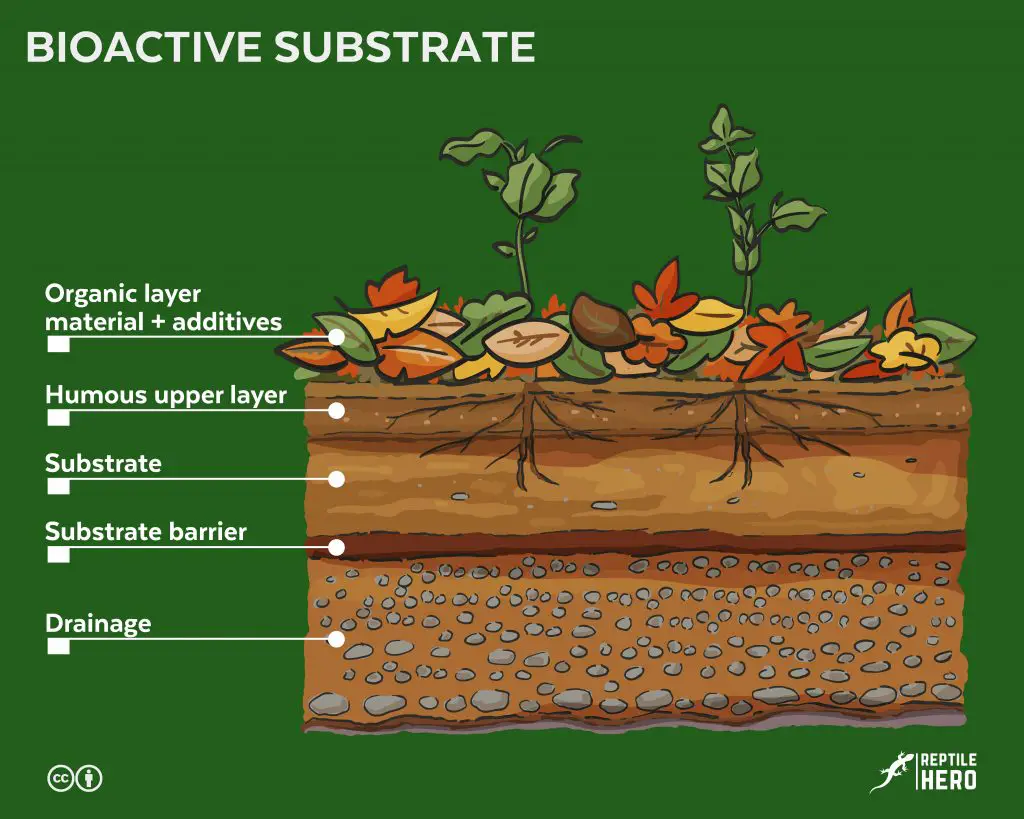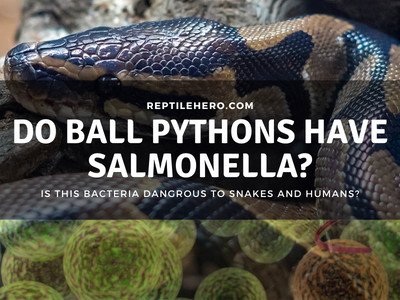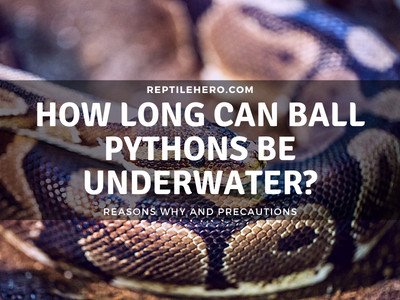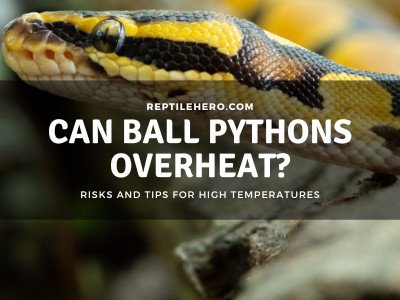What is a Bioactive Substrate? (Should You Use It?)
Whether you’re a newbie or you’ve been part of the reptile-keeping community for years, you’ve probably heard about bioactive substrates here and there. How different is a bioactive substrate from a normal one? What makes experienced keepers and breeders switch to it? Read on to find out!
In general, a bioactive substrate is complex and multi-layered reptile tank flooring. It is preferred as it facilitates the development of a miniature ecosystem that is designed to closely mimic the reptile’s native habitat to enhance overall welfare.
The benefits of a bioactive substrate outweigh the few drawbacks that come with it. Hence, it is highly recommended by reptile experts.
Learn more about the whole process in our article on creating bioactive substrates!
Bioactive Substrate for Reptile Tanks: The Best Option?

A bioactive substrate promotes and sustains natural biological processes in an enclosed area. It is a specific kind of tank flooring that provides various living animals and plants housed in the enclosure with optimal environmental conditions for them to thrive.
Different sources provide different dates for when the term “bioactive” was first used. One source in particular states that this word was used as early as 1938 [1]. It was conventionally used in the context of food and medicine.
However, it has only been adapted to reptile and amphibian—or just herps, collectively—husbandry for just about 2 decades. More specifically, bioactive setups have only been used for herps sometime in the middle of the 1990s [2].
Reptile Tank Setups and Bioactive Substrates
In the context of herp-keeping, the bioactive substrate is a complex soil mixture rich in good bacteria, fungi, and other beneficial microorganisms.
These develop due to the presence of non-toxic plants, decomposing organic materials, and various small animals called detritivores—more commonly referred to as the clean-up crew or CUC.
All of these, along with your cold-blooded pet, are essential ingredients that work together to sustain bioactivity in the tank. When any of it is missing, then you can no longer consider the substrate or entire set-up a bioactive one.
One of the major biological processes that take place in a reptile enclosure thanks to a bioactive substrate and set-up is the nitrogen cycle, which may sound familiar to you.
There are many other processes involved in keeping everything alive and thriving in such a set-up including, but not limited to processes involving water and oxygen.
9 Reasons to Choose a Bioactive Substrate for a Reptile Tank
Bioactive substrates for reptile tanks are preferred over others because they provide:
- Aesthetic appeal
- Dynamic setup
- Environmental niches
- Enrichment
- Self-sustaining
- Reduced intrusion
- Very limited foul odors
- Cost-effectiveness
- Improves well-being
The truth is, using bioactive substrates is not simply another trend that’s gained a huge following within the reptile community.
Owners have found that it can, in fact, significantly boost animal welfare! Even better? When compared with more simple and basic options, the bioactive substrate can be greatly advantageous for keepers and breeders in the long run too!
So let’s find out more!
1. Aesthetically Pleasing
Sure, a relatively more bare and sterile enclosure can be made to look great with various realistic-looking artificial decors and furnishings. But this is still a far cry from a well-design bioactive tank set-up!
With lots of greenery, a diverse clean-up crew, and many other organic materials filling up the space, a bioactive tank is undeniably more aesthetically pleasing. You pretty much have a gorgeous slice of nature right at home!
Having a bioactive set-up also helps with showcasing just how amazing and interesting our scaly babies can truly be.
2. Dynamic Environment
Aside from your pet reptile—be it a bearded dragon, gecko, snake, or whatever—the whole setup comes to life because of a good bioactive substrate. Nothing ever stays the same, just as their homes would be like in nature.
A key feature of a bioactive substrate is that it is ever-changing. Plants grow and bloom. Detritivores reproduce and move around. Organic materials break down and change. Colorful fungi sprout then disappear.
You will be able to watch all of these changes if you have a well-established bioactive substrate for your reptile tank.
Now if you think all of that is entertaining, just imagine how much more enriching it would be for your slithering, crawling, and climbing critters.
Reptiles would never get bored if they have such a dynamic substrate in their vivarium.
3. More Environmental Niches
Now, just to be clear having various environmental niches is not the same as ever-fluctuating tank conditions. What I mean by environmental niches is having many pockets of varying light, shade, moisture, heat, and other such factors.
This is actually what we should strive for if we truly want to provide our pet reptiles with a homey space in captivity. Having such choices for microclimates closely replicates what they would experience in nature.
Once they are about to shed, they have humid crevices to take shelter in. When they need to warm up, they have a basking spot to lay out on. If, on the other hand, they want to cool down, they can also burrow into the substrate.
4. Highly Enriching
Housing your cute pet reptiles in a tank that has been set up with a bioactive substrate is a sure way to effectively offer them different types of entertainment.
I would even argue that it’s one of the only efficient ways of providing your herps with the most multi-faceted form of enrichment.
Find out other ways to keep a reptile entertained in our article on enrichment ideas and toys.
Giving your pet a bioactive tank substrate will encourage foraging, burrowing, exploration, climbing, thermoregulation, and much more! Also, keep in mind that having a bioactive substrate will not only keep a reptile physically active but also mentally stimulated.
5. Self-Sustaining and Low Maintenance
Since a bioactive substrate has all the necessary elements in it, mainly your clean-up crew, to let it run its natural and biological course with very little human intervention. As a direct result, the whole tank setup for your reptile becomes greatly low-maintenance.
Your only tasks would be limited to misting (unless it’s already automated), glass/acrylic cleaning, and the like. Of course, you may also need to add more organic materials from time to time for your tank custodians and trim overgrown plants—among other things.
Plus, you can rest assured that your pet will thrive even when you have to leave it in the care of a friend or family while you’re away for a vacation!
6. Less Intrusive
Because you will no longer need to regularly do spot-cleaning and deep-cleaning sessions, you will no longer have to disturb and temporarily house your reptiles more than necessary.
This will translate to a less stressed and sickly pet, which is ideal for herps kept in captivity. However, you would still need to interact with them from time to time for feeding and social enrichment.
Remember: A reptile that isn’t under chronic undue stress is an animal that is happy and fit!
7. No Foul Odors
With a bioactive substrate, you will not have to worry about your vivarium and pet smelling incredibly bad.
Thanks to the presence of various helpful little animals—invertebrates, crustaceans, worms, etc., there’s little to no chance that your reptile tanks will be giving stale, musty, and/or pungent odors.
Rather, it would simply smell earthy which I find appealing and relaxing. It’s like I’m transported to a lush forest or an arid grassland by the smell of fully established bioactive substrates alone.
Once you do notice a foul smell emanating from a bioactive substrate, double-check to see if it’s the substrate itself or something else that’s giving an undesirable odor (e.g., uneaten food, infertile egg).
Discover more about eggs in our article on gecko eggs.
8. Cost-Effective
As mentioned before, a bioactive reptile tank setup is self-sufficient and requires very little maintenance. In other words, it is much more cost-effective in the long term compared to basic and intermediate substrate choices!
You won’t have to stock up on various cleaning products specifically made for pet reptiles because you’re custodians will do that for you. Additionally, you won’t have to repeatedly replace it once its gets soiled, which is often the case with a paper towel and non-bioactive loose substrate.
Then, if you one day plan on creating another bioactive tank setup, you can get good cuttings and established detritivore cultures from your first one!
Plus, since you’ve done such a build once before already, you’d probably become more familiar with cheaper and more accessible options for other stuff like soil mixes.
9. Improves Overall Well-Being
Last but not the least, a good and successful bioactive substrate enhances a captive reptile’s well-being as a whole—which I have hinted at numerous times in the previous paragraphs.
If you look at things closely, you will also realize that there’s virtually no reptile that becomes obese or sick when introduced to bioactive substrates that have been successfully set up.
Aside from letting reptiles actively hunt for food, explore the whole enclosure, hone their skills, sharpen their senses, and challenge them mentally, a bioactive tank also helps boost the animal’s immune system.
It has the same idea as letting kids play outside in the dirt to help them improve their immune response. Since they have grown adequately accustomed to various illness-causing organisms (pathogens), their bodies can effectively combat and eliminate such risks.
7 Cons of Making Bioactive Reptile Tank Substrates
Setting up and establishing a bioactive substrate for a reptile tank is a very complicated task even for experienced keepers. It requires a considerable amount of knowledge, experience, money, time, effort, space, and experimentation.
Reptile owners and enthusiasts have several concerns and fears—both substantiated and unfounded—that hold them back from giving their scaly babies a bioactive upgrade.
However, it’s important to keep in mind that keepers and breeders will only experience problems with bioactive substrates if it is not properly planned and put together.
Otherwise, you would only have to keep in mind the more practical disadvantages that come with bioactive builds—all of which I will be sharing with you.
1. Knowledge
There’s a lot of planning involved in setting up a bioactive substrate.
If you just approach the creation of a bioactive substrate haphazardly, you may end up hurting or even just killing the precious animal you were trying to care for.
You can’t just dive into your very first bioactive setup build head-first. Everything needs to be tailored to the specific reptile you are planning to house in the enclosure.
Even if you already have some knowledge of the native habitat and lifestyle of the specific reptile, you can’t just go by gut feel. That will never be right or enough to make up for things you aren’t aware of and factors you aren’t sure of.
For example, some plants that are safe for one reptile could be toxic to another.
Check out our article on which plants are safe for leopard geckos!
You have to dig in deep and do a lot of research to ensure that what you will be using and adding into the setup is appropriate for that specific herp.
2. Experience
Bioactive substrate requires a high level of expensive and knowledge to be set up correctly.
With the previous section, you now know and understand why it’s generally considered an advanced form of husbandry. This is the main reason why bioactive builds are often exclusively recommended just for expert keepers and breeders.
But even then, highly experienced reptile owners conducting supplementary research before their first attempt at making a bioactive substrate is not as rare of sight as many assume.
I would like to emphasize though that I don’t necessarily agree with only recommending bioactive set-ups for just keepers and enthusiasts with years of experience. Personally, I think we should introduce it right off the bat as it is considered the best husbandry practice.
Moreover, I have seen quite a few newbie reptile owners establish well-designed and balanced bioactive tanks with the help of other more experienced reptile-keepers in the community. So when in doubt, don’t hesitate to reach out!
3. Money
Bioactive substrates are expensive to set up.
This factor, I find, is one of the main drawbacks of getting into bioactive reptile tank builds. For good reason, I might add. Let’s face it, being able to keep a fascinating live animal as a pet can be extremely costly.
Of course, we have seen throughout the years that it’s possible to keep lizards, snakes, turtles, chameleons—and what have you—in very minimalist and barren enclosures. But after all those years, we also saw just how detrimental such a practice is.
So it’s almost a must to shell out quite a big amount of money to ensure that we can provide our lovely reptiles the good life they deserve. This is especially true when it comes to creating a bioactive tank setup.
If you get the short end of the stick and have to try multiple times before finally being able to establish a good ecosystem, all the costs add up further. As such, research and experience from credible sources and experts are vital before making any purchase.
4. Time
It can take from one to 6 months before a reptile can be safely housed in a tank with a fully established bioactive setup.
Creating a successful and thriving bioactive substrate can’t be done in a single day. Sure, you could gather all the materials you need to make one and put it together in one day.
But you can’t readily introduce your gorgeous reptile into such an enclosure right after that.
This is because of an essential process called “cycling” and this entire period is referred to as the “cycle time.”
To be more specific, the cycle time is an essential period in a bioactive setup to allow for:
- Plant roots to properly take root in the soil mix
- Custodians to reach a sufficient population
- Initial completion of biological cycles (e.g., decomposition)
- Fungi and mold bloom to subside
- Environmental factors (e.g., humidity) to stabilize
You can’t rush these events so you will really have to be patient.
5. Effort
Reptile owners will have to put in a lot of effort before, during, and after making the substrate making a good bioactive substrate.
It doesn’t stop after you’ve done enough research, gathered all necessary materials, planned the entire build, and completed the bioactive set-up. You also have to clean up all the mess you made and, though minimal, you still need to do some regular up-keeping.
A good handful of other people try to lessen the burden by buying expensive soil mixes and bioactive kits. I have also seen a few enthusiasts and shops offer bioactive tank build services.
However, I wouldn’t recommend you go via the latter route. That is, of course, unless they are highly reliable.
It’s just that I have seen a few sketchy listings that are incredibly vague and some have gotten scammed from seemingly good “bioactive substrate and enclosure” deals.
6. Space
Another downside to a bioactive substrate making that many reptile owners commonly overlook is the need for a large well-ventilated space for it the entire build.
You need storage space for all the materials. Then, you also need enough elbow room to be able to properly set everything in place.
Moreover, if you are planning to create a permanent background along with other physical structures with expanding foam and silicone, you need room for it to cure completely.
See what you need to look for in a reptile-safe adhesive and sealant in our article on silicones.
You would have to leave it in a partially open room or outside while also protecting it from the elements. A room you can temporarily close off from the rest of the living spaces in your house will do as well.
7. Experimentation
It is normal for even experienced reptile keepers to need a couple of adjustments while trying to establish the whole bioactive system.
A lot of things can go wrong even if you did the research and have years of reptile-keeping experience under your belt.
More often than not, you will struggle with keeping plants alive. You could be overwatering it or underwatering them. Another possible cause for dead plants is that the bioactive soil mix is not good enough. So you may need to tweak your recipe for that too.
It is also common for custodians to die down. In such cases, you may just need to add more detritivore cultures, ideally of varying kinds. Variety is always great for establishing a diverse and thriving bioactive setup.
Sterile VS Na+turalistic VS Bioactive Substrates
Generally, five factors differentiate the types of substrates used for reptile-keeping: components, cost, set-up difficulty, application, enrichment value, and maintenance. Overall, bioactive substrates are recommended for fit and healthy reptiles. Whereas naturalistic and sterile substrates are more suitable for reptiles with limiting conditions.
Some people think that substrates only differ in terms of material and aesthetic appeal. But this couldn’t be farther from the truth!
| Type of Substrate | Solid Sterile | Naturalistic Loose | Fully Bioactive |
| Components | Tiles or Paper Towel | Substrate mix (With or without drainage) | Drainage Substrate mix Biodegradables Clean-up crew Live plants |
| Cost | Cheap | Affordable | Expensive |
| Difficulty | Easy | Moderate | Hard |
| Application | Quarantine or Temporary | Long-term | Long-term |
| Enrichment | Little to none | Good but limited | High |
| Maintenance | Requires frequent replacement and cleaning | Requires regular replacement and cleaning | No replacement needed and only minimal cleaning required (Self-sustaining) |
Discover the finer details of the differences and similarities among the most commonly used reptile substrates below!
1. Solid Sterile Substrate
When you first start on your reptile-keeping journey, you’re likely to start with a solid and sterile substrate like a paper towel.
In fact, this is what’s advised for quarantine or so-called hospital setups. As soon as the paper towel flooring gets soiled, it’s necessary to replace it with fresh and clean sheets.
Then you’d probably upgrade to the sturdier and more aesthetically pleasing option: unglazed natural stone tiles.
Both of these are relatively cheap and easy to clean. However, neither of these are recommended for long-term reptile tank setups because they require frequent spot cleaning and provide little to no enrichment value to reptiles.
2. Naturalistic Loose Substrate
In comparison, a simple loose substrate is often paired with naturalistic enclosures. At times, potted live plants are also added into such a reptile tank setup. This is because it is harder to keep live plants alive after transplanting them directly into what’s basically infertile soil.
Upfront, a basic loose substrate is much more affordable than going for a bioactive substrate. But this needs to be replaced with fresh soil mix every 3 to 4 months.
Also, you would still have to remove all droppings on a regular basis as there are no detritivores to clean those up and then break them down properly.
Despite those pitfalls, a loose substrate is still a far more suitable choice for long-term reptile setups than solid options. It still encourages more natural activities and looks better overall.
3. Fully Bioactive Substrate
As I have mentioned for the majority of this article, experts in reptile-keeping consider a fully bioactive substrate as the best option.
This complex mix of drainage material, soil mix, biodegradable items, diverse clean-up crew, and flourishing live plants make it possible to have a virtually self-sustaining permanent setup.
Even though a bioactive substrate is expensive and difficult at the start, it ultimately becomes easier to maintain and more cost-effective as time goes on. What’s more, is that it offers your lovely pet reptiles a highly enriching environment.
Further Questions
Can I use a heat mat in a reptile tank with a bioactive substrate?
No, a heat mat can’t be used as a primary heat source, especially in a reptile tank with a bioactive substrate or just a loose substrate in general. It does not produce enough heat, to begin with, so having a thick layer of substrate on top of it will further hinder its heating capabilities. (Learn more in our article on heating.)
Are bioactive substrates only good for humid and temperate tanks?
It is a myth that bioactive substrates are only appropriate for reptiles in humid and temperate tanks. Although relatively newer, many reptile-keepers have had arid species thrive in tanks with a well-established bioactive substrate that is appropriately designed for their needs.
Will loose substrate cause impaction for reptiles?
Contrary to popular belief, the loose substrate will not readily cause impaction in reptiles unless they are kept in substandard conditions and/or are incredibly sick. Moreover, in their native environments, all reptiles live in areas with plenty of loose substrates. Nevertheless, products like calcium and vitamin sands are not recommended.
Summary of What is a Bioactive Substrate?
Bioactive substrates are increasingly being recommended for all reptile tanks because it has been shown to improve the general welfare of these animals.
Additionally, it provides various advantages including, but not limited to, various environmental niches, multi-faceted enrichment, and it is highly self-sustaining.
However, choosing to create a reptile enclosure with a fully functioning and well-established bioactive substrate requires a lot of money, resources, effort, patience, and expertise for a keeper or breeder to accomplish.
Sources
[1] https://www.merriam-webster.com/dictionary/bioactive#learn-more
[2] https://reptifiles.com/how-to-build-bioactive-terrarium/






